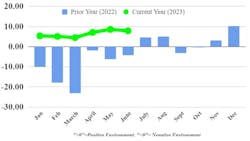Newly released readings from the monthly Shippers Conditions Index by FTR Transportation Intelligence provide further evidence that market conditions for freight hauling are precarious, thanks largely to fuel-price increases in July and this month headed toward last summer's records.
The U.S. average for diesel fuel rose significantly again—8.6 cents to $4.475—bringing the total surge for trucking's main fuel since July 24 to almost 67 cents per gallon, according to Aug. 28 data from the U.S. Energy Information Administration (EIA). The national gasoline average was down 5.5 cents to $3.813 per gallon the week of Aug. 28, but that consumer and small-fleet fuel also has risen sharply in recent weeks and sits pennies below the highs of 2022.
The fuel spikes appear on FTR's SCI, according to an Aug. 29 release from the industry data aggregators. The SCI fell in June to a 7.9 reading from May's 8.6 and "was impacted negatively by the recent jump in diesel prices," according to the FTR release.
See also: As rates still lag, trucking forecast is cloudy going into 2024
"Fuel is one of the most volatile components that can impact shipper conditions through its ability to move fuel surcharges and capacity around. It weakened overall shipper conditions in the latest month, but the SCI remained at a fairly positive level overall," said Todd Tranausky, VP of rail and intermodal. "If fuel prices continue to increase, it will push less positive readings in the SCI in the months ahead."
The SCI tracks changes in four primary conditions in the U.S. full-load freight market: freight demand, freight rates, fleet capacity, and fuel prices. The metrics are combined into a single index that tracks the market conditions that influence the environment for shippers. A positive score represents good, optimistic conditions; a negative one represents bad, pessimistic conditions.
FTR's Trucking Conditions Index (TCI) is also trending down, and with the Aug. 23 release of its TCI, Avery Vise, FTR's VP of trucking, pointed at elevating fuel prices as well. "The challenges are not uniform as the current market is hitting small carriers much harder than larger ones, especially considering the recent upturn in diesel prices," Vise added.
Ken Adamo, chief of analytics at another trucking data researcher, DAT Freight & Analytics, also said: "The sudden increase in fuel prices is testing the wherewithal of small carriers at a time when freight volumes are in a seasonal lull."





